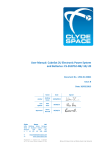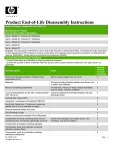Download NCV7691RCLV1GEVB User Manual
Transcript
Preliminary Information NCV7691RCLEVB NCV7691 8-channel Rear Combo / Daylight Running Light Evaluation Board User’s Manual http://onsemi.com EVAL BOARD USER’S MANUAL Prepared by: Ondrej Kupcik Updated by: Ladislav Bažant ON Semiconductor Introduction The evaluation board demonstrates rear combination / daylight running light (RCL/DRL) solution with up to eight LED string. The board regulates constant current of 100 mA (68 to 150 mA) through each onboard LED string consisting of three red or two white LEDs in the wide range of the supply voltage. The current is reduced for the board temperature above 90°C. The board is designed in order to provide good cooling of the active components with no extra cost. Additionally, a heat sink may be mounted on the bottom side of the board to improve the thermal capability of the board. In case of LEDs short or opening, the current sources are disabled and the fault may be detected by the ECU diagnostics. On-board LEDs may be easily replaced by external ones. Evaluation Board Features • • • • • • • • • • • • Wide range of supply voltage: 7 to 40 V Eight LED strings with on-board red or white LEDs (RCL/DRL) Nominal LED current 100 mA (150 mA max.) Over-temperature current fold-back protection OPEN jumper in each string allowing LEDs disconnection SHORT jumper in each string for short emulation or connection of the external LEDs Led short-circuit and open-load emulation jumpers Optional external PWM input Optional Error flagging through indication LED and FLTS output Positions for optional EMC capacitors One-side components assembly Passive cooling (optional heat sink may be attached to the bottom) © Semiconductor Components Industries, LLC, 2015 May, 2015 – Rev i2.10 http://onsemi.com EVBUMXXXX Publication Order Number: Figure 1: Running NCV7691 Evaluation Board Picture Table 1. Absolute Maximum Ratings Rating Supply Voltage (Vbat) LED String Current (thermally limited) PWM, FLTS, Err Voltage (J1 connector) Error pin current (J1 connector, pin 3) Junction Temperature (NCV7691, BCP56) Junction Temperature (ASMT-QRBD-AEF0E, ASMT-QWBF-NKL0E) Ambient Temperature Value -40 to +40 150 -0.3 to Vbat 0 to 200 -40 to +150 -40 to +125 -40 to +105 Unit V mA V mA °C °C °C Table 2. Recommended Board Operating Conditions Rating Supply Voltage (Vbat) Rated LED string Current (VS < 18 V, Tboard < +90°C) Open-Load or Short-Circuit board consumption (VS = 14 V) Ambient Temperature (for rated LED current) Value 7 to 18 68 /100 /150 max. 7 -40 to +70 Unit V mA mA °C Preliminary Information Rear Combo / Daylight Running Light Evaluation Board Schematic Figure 2: NCV7691 RCL/DRL Evaluation Board Schematic http://onsemi.com 3 Preliminary Information Table 3. Interface Function Description Connector Name VBAT OPEN1-8 Connector Type 2.1 mm DC supply SMD Jumper SHORT1-8 SMD Jumper B Col1 Col5 FB FB1 FB5 Test Point Test Point Test Point Test Point Test Point Test Point J1 SMD Header Description / Function Supply battery input Removing the jumper emulates open LED condition Shorting terminals by the jumper emulates short LED condition OR terminal for external LEDs BASE output of NCV7691 / NPN base String 1 NPN collector String 5 NPN collector FB output of NCV7691 String 1 NPN emitter / feedback resistor String 5 NPN emitter / feedback resistor Control/diagnostic functions: Pin 1: GND Pin 2: PWM input (10k pull-up to VS) Pin 3: Error signal (active low, pull-up to VS through LED and 10k) Pin 4: FLTS pin of NCV7691 Pin 5: Alternative pull-up input for the error signal (if used, remove R9’) Getting Started The board is supplied through a standard 5.5 x 2.1 mm DC connector. Nominal supply voltage ranges from 7 to 18 V. Below 7 V, the current through the LEDs starts decreasing. For battery voltage above 18 V, the LED current is reduced by the over-voltage fold back to reduce the power dissipation. The thermal fold-back circuitry ensures the board temperature remains within the safe range (see following chapter for details). Two jumpers in each string emulate LEDs short or opening. By default, OPEN jumper is closed while SHORT terminals are not shorted. Alternatively, external LEDs may be connected through SHORT header while on-board LEDs are disconnected. 7 to 18 V 2.1 mm DC supply The LEDs current is defined by Rx1 resistors. By default, it is set to 100 mA, but may be changed using following formula: • • With no thermal fold-back (NTC pin grounded): 𝐹𝐹𝐹𝐹 𝑅𝑅𝑅𝑅𝑅𝑅𝑅𝑅𝑙𝑙𝑙𝑙𝑙𝑙𝑙𝑙𝑙𝑙𝑙𝑙 𝑉𝑉𝑉𝑉𝑉𝑉𝑉𝑉𝑉𝑉𝑉𝑉𝑉𝑉 0.15 𝑅𝑅1 = ≈ 𝐼𝐼𝐿𝐿𝐿𝐿𝐿𝐿 𝐼𝐼𝐿𝐿𝐿𝐿𝐿𝐿 With thermal fold-back circuitry on NTC pin: 𝑉𝑉𝑁𝑁𝑁𝑁𝑁𝑁 1.5 0.15 𝑅𝑅1 = ≈ = 10 ∙ 𝐼𝐼𝐿𝐿𝐿𝐿𝐿𝐿 10 ∙ 𝐼𝐼𝐿𝐿𝐿𝐿𝐿𝐿 𝐼𝐼𝐿𝐿𝐿𝐿𝐿𝐿 LED current programming resistors Thermal fold-back circuitry NCV7691 Positions for optional EMC resistors Figure 3: NCV7691 8-channel Evaluation Board Picture Modules control strategy The board is designed to operate in standard “One Wire Driver Body ECU” and decentralized architecture. In the first case, both control and diagnosis is done through one supply wire. The dimming might be provided through the PWM applied to the High-side SmartFET in the body ECU. At the same time, the SmartFET allows diagnosis of the failure on the LED module (open load or short-circuit) (see Figure 3). In case of both LED short and disconnection, NCV7691 disables all the NPN bipolars. In decentralized operation, extra wires are needed for the control and diagnosis (Figure 4). For this purpose, header J1 is available on the board for easy access to FLTS and PWM functions of NCV7691. http://onsemi.com 4 Preliminary Information Normal operation LED string open LED string short ECU ECU ECU control diagnostics control control diagnostics NCV8460A RCL / DRL 7 mA max. @ 14 V RCL / DRL open 8x 100 mA NCV7691 NCV8460A 7 mA max. @ 14 V 0.8 A RCL / DRL diagnostics NCV8460A short NCV7691 NCV7691 Figure 4: Centralized One Wire System Diagram Normal operation LED string open LED string short ECU ECU ECU Control / diagnostics Control / diagnostics Control / diagnostics error RCL / DRL error RCL / DRL RCL / DRL open NCV7691 NCV7691 Figure 5: De-centralized System Diagram http://onsemi.com 5 short NCV7691 Preliminary Information Open LED string diagnostics VS NCV7691 includes Open Load Detection feature. When the LED is open, the control loop tries to increase the BASE current to reach 152 mV on the FB pin. As the BASE current is limited to typ. 25 mA, the FB voltage drops below the target level. When the FB voltage decreases below the Open Load Detection FB Threshold (typ. 75 mA), an open load is detected after a period defined by a capacitor connected to the FLTS pin. Figure 5 demonstrates an open load situation on two-string application. V(SC) > (VS - 2 V) -> -> FLTS curre nt source active -> LEDs o ff VS-0.5V BCP56 BCP56 NCV7691 1R5 1R5 SC BAS E FB GND BCP56 ~24.8mA ~0.2mA 90mV NCV7691 SC BCP56 37.2mV 1R5 60mA 25mA Figure 8: Short LED detection principle 1R5 Thermal considerations of the board 24.8mA BAS E FB GND 63.6mV V(FB) < 75 mV -> -> FLTS curre nt source active -> -> LEDs o ff Figure 6: Open load detection principle In multi-string applications with high-beta transistors, the feedback voltage from individual strings is averaged, so one defective LED string does not always lead to the open load detection. One of the ways to improve the open load detection capability is more precise external BASE current limitation. An example of the circuit with one extra resistor and PNP bipolar is shown in Figure 6. As the board dissipation is typ. 11 W at 13.8 V battery supply and 100 mA LED current, the thermal aspects should be taken into account for the board design. The main limitations are LED lifetime vs. operating temperature and NPN bipolar maximum junction temperature. The board was designed to operate at full current with board temperature of up to 90°C on standard 70 μm FR4 PCB substrate and passive cooling without any extra thermal improvements. In case higher power dissipation is foreseen, a cooling metal profile may be mounted to the bottom side of the board, Thermal fold-back To the protect power dissipating devices on the board (LEDs, NPN bipolar transistor), a circuit reducing LED current at high board temperatures is included (Figure 8). VS R3 10k BCP56 ~9.3mA ~0.1mA NCV7691 ~10mA R4 100k 45mV 47R 1R5 30mA 1R5 4V7 10.9mA R5 51k 57.3mV GND BC856 R6 560k PTC to NTC pin BAS E FB Temperature dependent element Voltage reference 14mV max. SC ~4.3 V BCP56 V(FB) < 75 mV -> -> FLTS curre nt source active -> -> LEDs o ff T < Tsense: 470 Ω T = Tsense + 15°C: >40 kΩ Figure 9: Thermal fold-back circuitry Figure 7: Improved open load detection for 8 strings Short LED diagnostics NCV7691 contains a LED string short detection based on LED string voltage measurement (pin SC). In case the voltage difference between the VS and SC pins drops below typ. 2 V (Figure 7), the BASE is switched off and FLTS current source is active to flag an error. In multi-string applications, an OR-circuitry (e.g. diodes) has to be used to cover all the strings. The circuit consists of a voltage reference (ZD1 supplied via R3) and temperature dependent resistor divider. A thermistor with positive temperature dependency (PTC) is used for temperature sensing. For temperatures below the PTC sensing temperature, the thermistor has low resistance (typ. 470 Ω), so the circuitry output voltage is given by R4 and R5 while for high temperatures the reference voltage drops rapidly (Figure 9). R6 ensures the voltage on NTC input does not fall below the NTC Detection Level (max. 300 mV) at high temperature, which would result into a switch-over to the internal voltage reference of NCV7691. http://onsemi.com 6 Preliminary Information 4.3 V 4.3 V R4 100k T < Tsense R4 100k R6 560k PTC ~ 470R R6 560k 1.45 V to NTC pin 0.31 V to NTC pin R5 V(NTC) has to be > 0.3 V R5 51k T >> Tsense PTC → ∞ The sensing temperature (PTC parameter) has to be chosen carefully with respect to the heat distribution over the board and thermal properties of the power dissipating components. For PTC type B59641A95A62, the current fold-back reduces the reference voltage on the NTC pin and thus LED current above the board temperature of ~90°C (Figure 11). 51k Figure 10: Thermal fold-back circuitry at low / high temperature The optimal Zener voltage in terms of the temperature independency is usually between 4 and 5 V. At the same time, it should be as low as possible to allow a low-battery operation. 4V7 Zener diode is recommended as a good tradeoff. Because of lower bias current (< 1 mA) and impedance of the Zener, the reference voltage is lower than the nominal one (~4.3 V for 4V7 Zener) (Figure 10). Figure 12: NTC voltage vs. board temperature (VS=12V) If the thermal fold-back feature is not required, components R3, R4, R6, ZD1 and PTC do not need to be assembled and NTC pin should be tied to GND (directly or via R5). EMC recommendations Figure 11: NTC voltage vs. supply voltage (Tpcb = 25°C) If extensive EMC immunity level is required, Cx1, C3 and C4 capacitors can improve the EMC performance. Using C3 is usually sufficient against disturbances from the supply line. Capacitors Cx1 and C4 may further improve the performance esp. in the setups with external (off-board) LEDs. http://onsemi.com 7 Preliminary Information PCB Drawings Assembly Drawings Figure 13: NCV7691 RCL EVB PCB Top Assembly Drawing (Red LEDs) Option A Figure 14: NCV7691 DRL EVB PCB Top Assembly Drawing (White LEDs) Option B Composite Drawings Figure 15: NCV7691 RCL/DRL EVB PCB Top Composite Drawing http://onsemi.com 8 Preliminary Information Figure 16: NCV7691 RCL/DRL EVB PCB Bottom Composite Drawing http://onsemi.com 9 Preliminary Information REFERENCES [1] [2] [3] ON Semiconductor, NCV7691 Product Datasheet Rev. 2, January 2015. EPCOS, PTC thermistors as limit temperature sensors, Series: B59421, B59641, B59721, March 2014 ON Semiconductor, BCP56 NPN Silicon Epitaxial Transistor, Rev. 10, March, 2014. http://onsemi.com 10 Preliminary Information ON Semiconductor and are registered trademarks of Semiconductor Components Industries, LLC (SCILLC). SCILLC reserves the right to make changes without further notice to any products herein. SCILLC makes no warranty, representation or guarantee regarding the suitability of its products for any particular purpose, nor does SCILLC assume any liability arising out of the application or use of any product or circuit, and specifically disclaims any and all liability, including without limitation special, consequential or incidental damages. “Typical” parameters which may be provided in SCILLC data sheets and/or specifications can and do vary in different applications and actual performance may vary over time. All operating parameters, including “Typicals” must be validated for each customer application by customer's technical experts. SCILLC does not convey any license under its patent rights nor the rights of others. SCILLC products are not designed, intended, or authorized for use as components in systems intended for surgical implant into the body, or other applications intended to support or sustain life, or for any other application in which the failure of the SCILLC product could create a situation where personal injury or death may occur. Should Buyer purchase or use SCILLC products for any such unintended or unauthorized application, Buyer shall indemnify and hold SCILLC and its officers, employees, subsidiaries, affiliates, and distributors harmless against all claims, costs, damages, and expenses, and reasonable attorney fees arising out of, directly or indirectly, any claim of personal injury or death associated with such unintended or unauthorized use, even if such claim alleges that SCILLC was negligent regarding the design or manufacture of the part. SCILLC is an Equal Opportunity/Affirmative Action Employer. This literature is subject to all applicable copyright laws and is not for resale in any manner. PUBLICATION ORDERING INFORMATION Literature Fulfillment: Literature Distribution Center for ON Semiconductor P.O. Box 5163, Denver, Colorado 80217 USA Phone: 303–675–2175 or 800–344–3860 Toll Free USA/Canada Fax: 303–675–2176 or 800–344–3867 Toll Free USA/Canada Email: [email protected] JAPAN: ON Semiconductor, Japan Customer Focus Center 2–9–1 Kamimeguro, Meguro–ku, Tokyo, Japan 153–0051 Phone: 81–3–5773–3850 Email: [email protected] N. American Technical Support: 800–282–9855 Toll Free USA/Canada For additional information, please contact your local Sales Representative. ON Semiconductor Website: http://onsemi.com http://onsemi.com 11











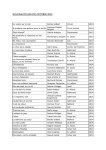
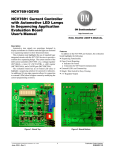
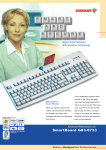


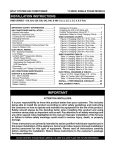
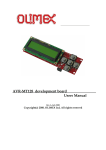
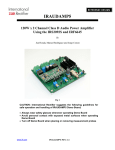
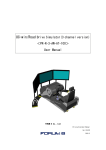

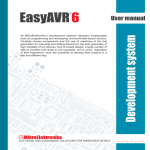


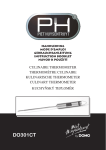
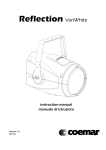



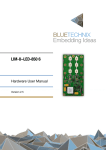
![LEGASIC IrCOMMアダプタPro Plus[ 137KB]](http://vs1.manualzilla.com/store/data/006589505_2-7f310eff1596309770aaa67c0dbcdaf0-150x150.png)
